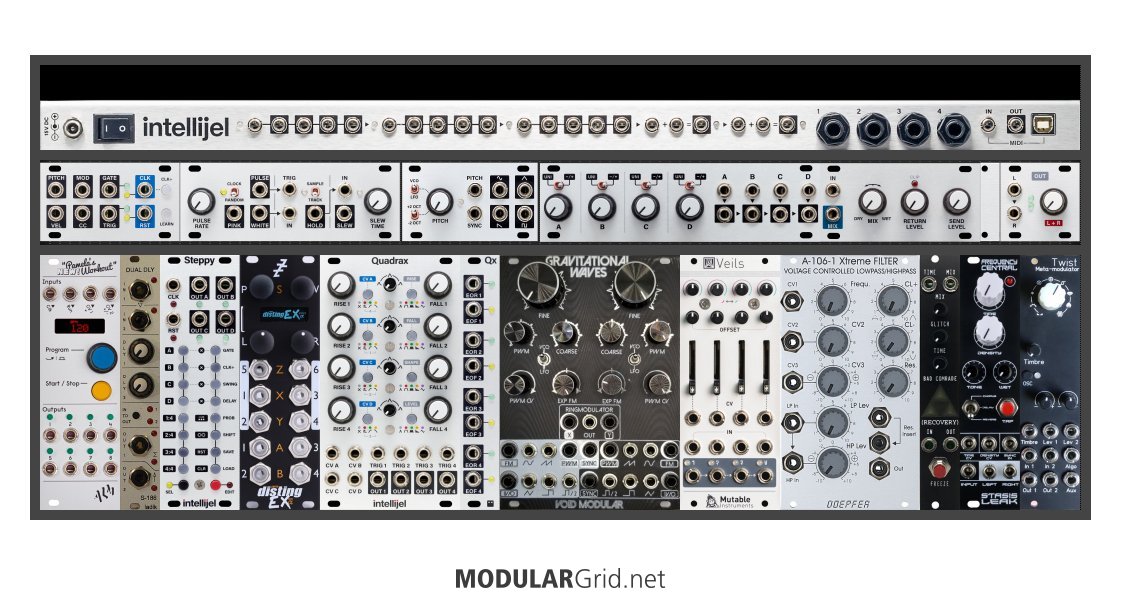OK...first up, 3U x 84 is just not a good starter case size. It's small, as Jim notes...small enough that you'll be making compromises that you probably won't like. So, taking your intentions and mixing 'em up with Jim's notes, I cooked this up:

First of all, I jacked this on up to an Intellijel Palette 104. Instead of the previous cab, this gives you a utility tile row AND the power supply/header half-row. By doing this, you can then move some of your functions up into the tiles, plus the header gives you three buffered mults (usable as one HUGE buffered mult) and two adders. And a MIDI port. Oh, and four 1/4" jacks. We'll get to those in a bit...
Tiles: MIDI Interface. NOW you can connect this to your DAW's MIDI. This will give you a synced clock, also. Then the Intellijel Noise Tools provides a noise source, slew limiter, sample and hold, and another clock that can also spit out random pulses. Then there's a utility VCO that doubles as an LFO with CV and sync. The QuadrATT provides mixing, but also polarization, and a breakable summing bus. Then the first 1/4" jack thing: a Pedal I/O, which lets you drop in various FX processors or, if you like, you can use the return line as an audio input. This makes use of a pair of the 1/4" jacks for its own I/O. And last, the stereo output. No, the Befaco isn't in here, because NOW you can output from the build via the Stereo Out and its 1/4" jack pair...no need to rob 4 hp for the output.
Row: Pams first, then a Ladik dual pulse delay lets you offset two channels of pulses on the fly. I kept the Steppy because now, it makes a decent sequenced trigger for the Quadrax...or you can use the Quadrax's QX expander's EOR/EOF pulses to fire it in ways that can, if wanted, turn the entire Quadrax into a complex LFO. Hell, you could even clock a channel or two of the Quadrax at audio rates to use those function gens as extra oscillators WITH CV over the rise and fall values. And in the same vicinity, there's the Disting EX to provide all sorts of ancillary functions...quantizing makes sense, but there's OTHER weird things it's very capable of with the other modules in here.
Now, for the voice section, I opted for a more "proper" complex oscillator, as that'll give you your dual VCOs for fattening up the sound. But you don't have to do that with this; instead, you can FM one oscillator via the other, you can AM them by using the ring modulator, or you can entertain a bunch more weird routings, all of which gives you some really rich timbres before even hitting the VCF. Next, a quad VCA (Veils) lets you strum through various waveforms, which more or less gives you some simple timbral sequencing, or you can use one half of it for audio from the Gravitational Waves while reserving two more for modulation amplitude functions.
The next two modules actually work in tandem. First up is Doepfer's take on the MS-20 Sallen-Key VCF pair...which, strangely, includes an insert loop in the resonance path. And for that insert loop, I added that second module, Recovery's Bad Comrade mkiii, which is a delay line with many ways to cause glitches, freezes, etc etc, which the resonance path then takes back in...so, as each sound loops through the Bad Comrade, you have ample opportunities for seriously messing with it, then it all accumulates back in the VCF...and around you go again!
Last, some effects. First up is a Stasis Leak, which I find comes in very handy for "stereoizing" audio. It's a mono in-stereo out reverb/chorus/tap delay...and yes, you can use the Steppy to define/redefine that tap delay length as a sequenceable function. Then the end of the 3U stuff has a Warps clone, which lets you do a lot of pitch change, various other modulations, stereo ring mod, and so on.
Now THAT'S a serious and small production rig. Instead of the previous version, this has a lot of open-endedness to it that keeps it from being a "one-trick" build. Timbral variety is REALLY big in here, plus the Steppy has the ability to mess with certain other functions, AND you can offset it in time from the Pams with the Dual Pulse Delay. But by going a big bigger, adding the extra tile and header rows, NOW this is working at the right capability for a really diverse system that still fits nicely under one arm.

